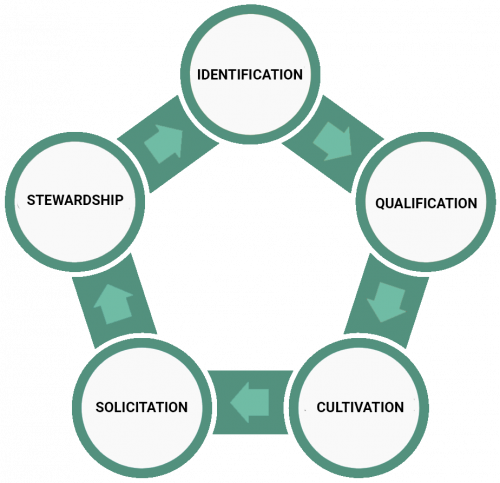Fundraisers spend very little time “making the ask” but it can take months to get to that moment. Every fundraiser goes through a cycle before they can actively solicit, and each stage of that cycle is important.
Every stage of the fundraising cycle is an opportunity to realize the full potential of your donor relationship. To make the most of each stage, you need to implement some data analytics processes. By leveraging fundraising intelligence tools, you can make sense of your donor data and apply data-driven strategies in your fundraising cycle.
This article will learn the five stages of a fundraising cycle and discover the fundraising intelligence tools and strategies needed for each stage.
5 Stages of a Fundraising Cycle

1. Identification
The identification stage of the fundraising cycle is where you determine who your donors are and what you are asking for. At this stage, you can look to both new potential donors and existing donors to identify ideal prospects for your fundraising campaign.
Potential donors are new to your nonprofit’s donor database and have never donated before. To identify if these donors are ready to be a part of the fundraising cycle, you will need to assess their readiness to give and test the waters by sending an email or giving them a call to see if they are engaged.
Your existing donors are donors who have donated before and may be ready to donate again. Each donor is on a different journey and may be ready to donate again at a different time. You will need to assess each donor to determine if they can donate this cycle.
You also need to set your fundraising goals for this cycle. Setting a specific goal, such as the dollar amount for a new infrastructure project or the cost to run a program for a year, will give you a clear target. You can then clearly communicate this target with your donors and keep them updated as the campaign progresses.
Pro Tip
Instead of manually combing through your donor database and analyzing each donor to determine their potential to donate this cycle, you can use a fundraising intelligence tool like KIT.
Fundraising intelligence tools can help you narrow down a list of prospects for a campaign. These tools can help you identify potential donors by sorting and segmenting them in your database based on historical data such as giving patterns and engagement levels.
How Well Do You Know Your Donors?
Fundraising KIT provides you with essential contact insights such as the best way and time of year to reach out to each donor. With such insights and predictions, you can understand your donor behavior and steward them accordingly.
2. Qualification
The qualification stage is where you whittle down your list of potential donors from the identification stage. By researching potential donors to get to know them better, you can determine whether they are viable for this campaign, essentially curating a list of the donors who are most likely to give.
From here, you can develop a personalized cultivation and solicitation strategy for each donor, which will be used in the next stages of the fundraising cycle. Each donor is different, and curating a personalized, targeted solicitation strategy based on their interests, giving capacity, and past donor records will boost your chances of receiving contributions from them.
Pro Tip
With the right fundraising intelligence tools, you can automate most of the qualification stage. If your donor database is up to date, tools like KIT can use the data you already have to develop a cultivation strategy that’s specific to each donor. Using predictive fundraising analysis, you can discover the solicitation channel that’s ideal for donors.
3. Cultivation
The cultivation stage of the cycle is when you develop your relationship with each donor and put that personalized solicitation strategy into action. Your goal is to help donors feel connected to your nonprofit organization and its mission.
You can do this through face-to-face meetings, engaging them as volunteers, involving them in programs, and sharing updates with them regularly. Determining the best way to do this for each individual is where fundraising intelligence tools come in.
Pro Tip
Even in relationship building, data can be an extremely useful ally. Fundraising intelligence can help you create a more tailored cultivation strategy for each donor. Collecting donor data like preferred method of contact and best time to contact allows you to reach donors in the best way for them.
Furthermore, your fundraising intelligence tool can tell you whether to send an email or a letter and even how long to wait before messaging again.
Download FREE Thank You Letter Templates
Saying “thank you” is a vital part of a nonprofit fundraising strategy. Use these templates to craft general, campaign, and impact-focused thank you messages.
4. Solicitation
The solicitation stage is where you actually make the ask. Now that you know the ideal donor for your campaign and cultivate a budding relationship with them, you can approach them to ask for a donation. This is a key moment in the donor journey and after all of the work you have put in to get to this point, you want to make sure that you are making the right ask.
Be specific with your ask. You want to be clear about exactly how much you are asking for, so suggesting a range is helpful. You also want to clarify what the money is going towards, so naming the program or even the general costs that the donation will support is helpful.
Pro Tip
One of the stressful parts of this stage is knowing how much to ask for. Fundraising intelligence tools can help you make an informed decision about the range that you ask for. Using donor giving history and readiness score, KIT can suggest the right amount and the right time to ask.
By asking for the right amount, at the right time, you can optimize your chances for a donation, and the results will show in your conversion rate.
5. Stewardship
Your job isn’t over after the donation is made. You are playing the long game, so you need to have an eye for the longevity of your donor relationship. At the stewardship stage, you want to maintain the relationship and show them just how thankful you are for their gift and the impact it has made on your organization.
Pro Tip
You can use fundraising intelligence to track the impact of each donor’s contribution. Use data visualization tools to build up a clear picture of how their donation has helped specific programs or beneficiaries. Be sure to thank donors and restate how their donation is being used.
Once you have thanked donors for their gifts, you will need to maintain the relationship. Depending on the donor, this can be very low touch, using regular personalized email campaigns. The right fundraising tool can also nudge and remind you to check in on donors who you haven’t been in touch with for a while.
Artificial intelligence tools can also help you keep track of your organization’s performance as a whole so you can demonstrate the impact to your donors. For example, remember that fundraising goal you set at the beginning of the cycle? You can use fundraising intelligence tools like KIT to track your progress towards those goals and share that with donors.
Fundraising intelligence tools help you optimize each stage of the fundraising cycle. They can also help you track where each donor is in the cycle, how they are progressing and where they may need help. These tools allow you to harness the power of data in your fundraising cycle, so you can be more strategic at each stage and reach your fundraising goals.

Ally Smith
Content Writer at Fundraising KIT
With a passion for nonprofit innovation, Ally has spent her career helping build community capacity and supporting social innovation as a customer success manager turned, youth worker, turned social researcher.
After leaving the tech start-up landscape, she pursued a Master’s in Philanthropy and Nonprofit Leadership and has since supported nonprofits to innovate and grow. A Canadian ex-pat and social entrepreneur based in Edinburgh, she enjoys hiking, baking bread in a panic, and pursuing the full Scottish experience- rain and rugby included!







